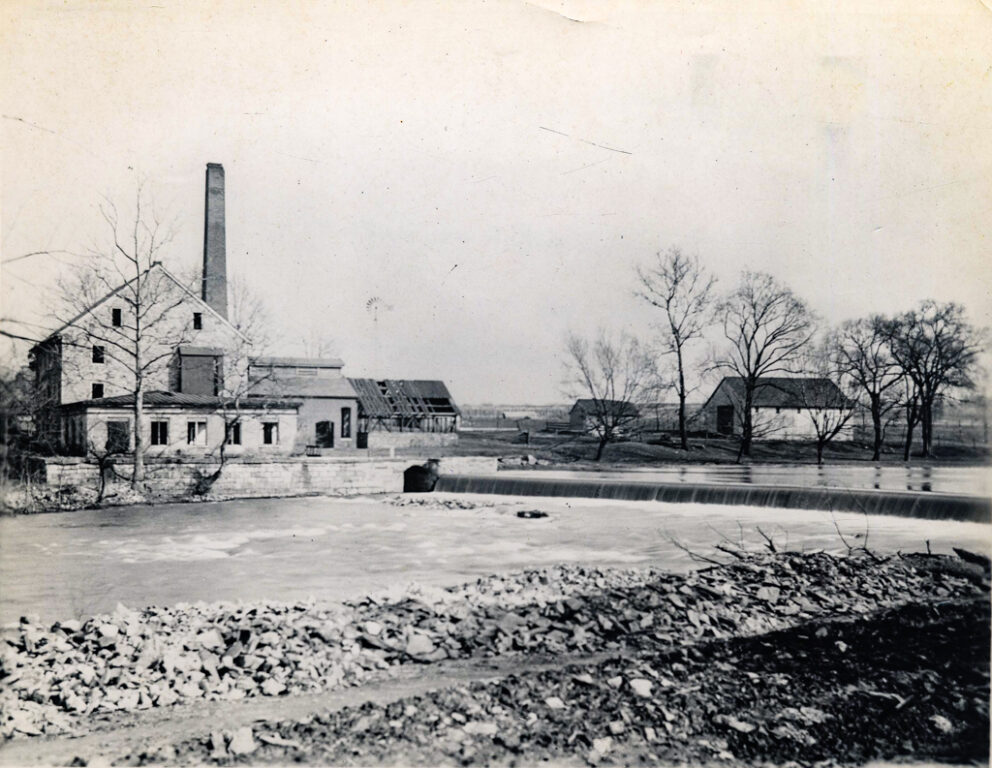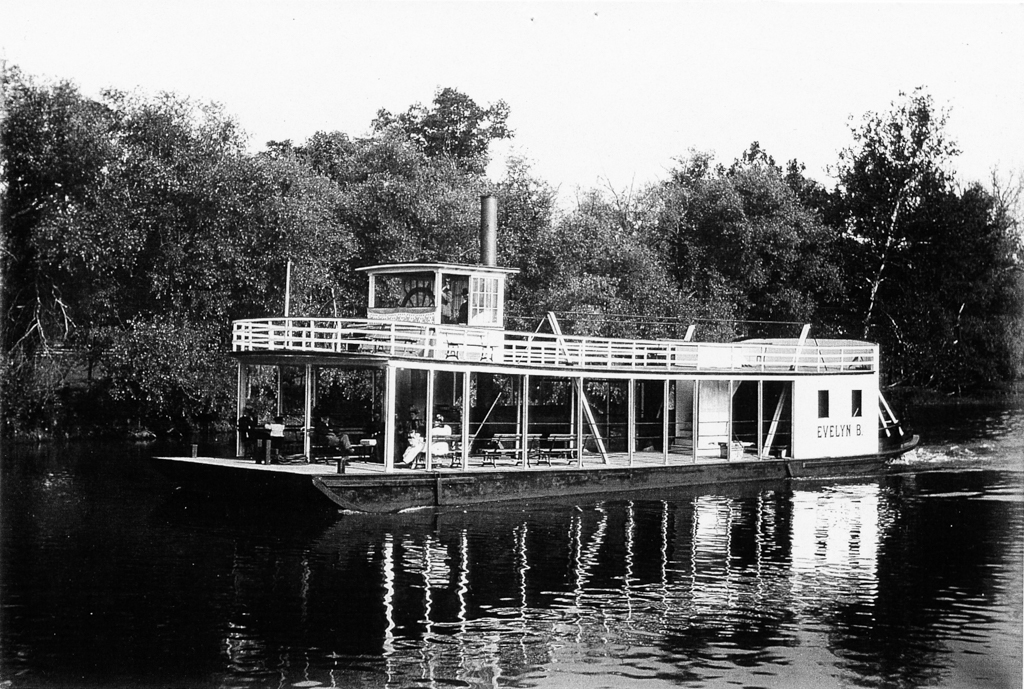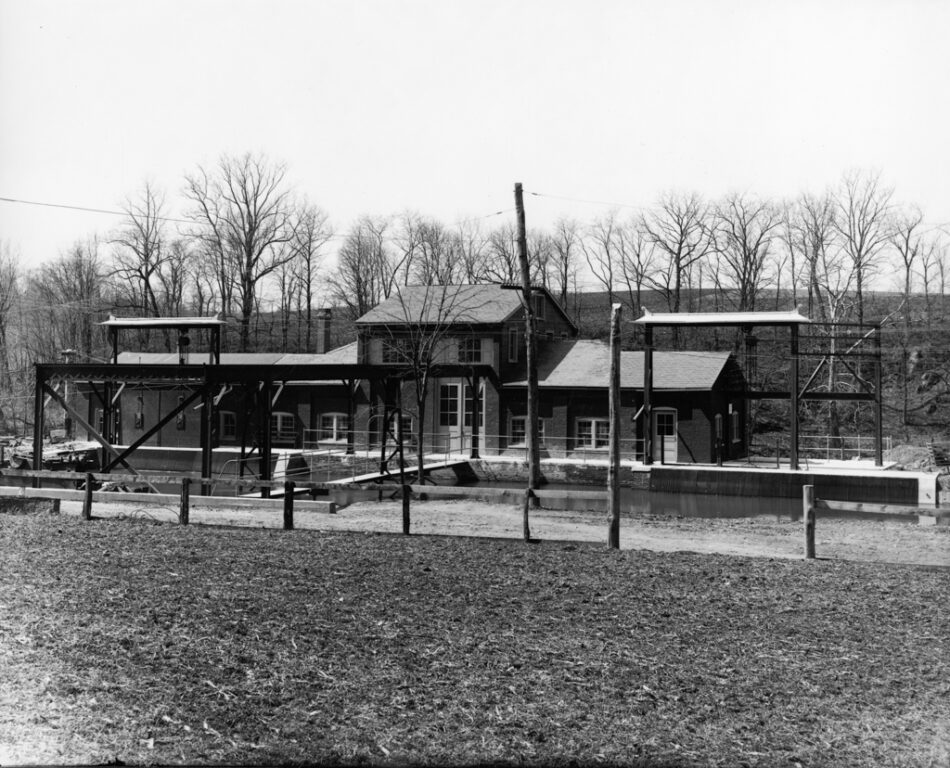This is the third article in the series in which we are taking a journey through time on the historic waters of the Conestoga River. In the first article, I covered the conditions of the Conestoga prior to European settlement. We looked at how the Conestoga watershed looked very different than it does today. The second article covered the colonial settlement era. We saw how the river provided transportation for commercial endeavors from the fur trade to the slack-water canal.
In this installment, we will cover the Victorian era. During this time, the river ceased being a means of transportation, but recreation became the primary focus. And, as the population grew, the urban areas depended on the river as a source of water and as a means for waste disposal.
Ice
Ever since colonial times, the river was a source of ice for the city and surrounding area. In the winter, when the river was frozen, men would cut the ice into large blocks using iron saws made for the purpose. The ice blocks were stored in icehouses that lined the riverbank. These houses could be as much as three stories tall and were packed with ice from floor to ceiling. The ice blocks were covered in straw and sawdust to prevent melting. Throughout the year, but especially during the summer months, the ice man would make his way through the back alleys with his horse-drawn cart bringing ice to the people who had iceboxes in their homes. Sometimes the boxes were built into the wall with an outside opening so the ice man could refill the box without needing to enter the home. In other cases, the delivery man had to enter the kitchen with a block of ice in his tongs to be placed into the family’s icebox. When manufactured ice became available in 1895, the need to harvest ice from the river declined. Household refrigeration started to become available in 1925. Today, we simply need to push a button on the front of our refrigerator door to fill our cup with crushed ice.
Bringing Water to Lancaster City
For the first one hundred plus years after the founding of the town of Lancaster, its inhabitants had to rely on wells, pumps and springs for their water supply. But as the city grew, these became inadequate to serve the population. As early as 1789, General Hand, who was serving as burgess at the time, lamented about the millions of gallons of water going to “waste” in the Conestoga River every year. But the prospect of bringing water from the river up to the town was considered an impossibility at that time.
Thirty-six years later, the state legislature authorized the formation of the Lancaster Water Company and granted the company to sell stock. Not much happened until 1831 when the legislature also granted the city the right to levy taxes to support the water works. The city hired engineer W.B. Mitchell to survey the possible options, and finally in 1836, the city built its first water plant. The plant was located at the site of an existing grist mill and dam southeast of the city at the lower end of City Mill Road. A water wheel powered a series of pumps that carried water from the river up to a newly built reservoir on King Street next to the county jail. On Washington’s birthday, February 21, 1837, operations began, and water from the Conestoga began to flow through water plugs in the city. Wastewater returned through various conduits back into the Conestoga, including any materials that were added to the mix in the process.

The abundance of water inspired some of the more well-to-do citizens to install bathtubs in their homes. The first to do so was Jacob Demuth, who installed a tub in 1839. Soon after, there were found to be eight more tubs in city homes. At this, the city council assessed a bathtub tax of three dollars annually. Nine out of ten doctors of that time were unconvinced that such frequent bathing was healthy. The tenth doctor, Dr. John Light Atlee, begged to differ, and installed a tub in his home in 1849. Even though the cholera outbreaks of 1832 and 1854 were blamed on “misty clouds of putrefying organic matter decaying along the streams and canals,” Dr. Atlee believed the disease might be caused by some tiny organisms he could see in his microscope. He was proven correct thirty years later when germ theory became better understood.
In 1888, the old water plant at the city mill was replaced with a new pumping station along the Conestoga River near the railroad bridge on Grofftown Road. Two large steam pumps operated with a daily capacity of eleven million gallons. These were placed on a reserve basis in 1929, when eight electrically driven and three gasoline-powered pumps were installed. The current water-treatment plant located along the Susquehanna River in Columbia was constructed in the 1950s. The Grofftown Road plant was removed in 1976. A small reserve pumping station is located across the river next to Conestoga Pines Park.
Recreation
Following the Civil War into the beginning of the twentieth century, various kinds of recreation became popular. Lancaster City had parks on both sides of the city, Wabank, Gable’s Woods, and Maple Grove on the West side, and Conestoga Park, Williamson Park, Rocky Springs and Peoples’ Bathing Resort on the East.
In 1854, a group of investors from Lancaster purchased two tracts of land at lock #3 of the Conestoga Navigation Company, which included an old tavern, several mills and a miller’s house and approximately sixteen acres of land. They replaced the old tavern with a grand hotel that they named “The Wabank House”. The house measured 105 feet long and 45 feet wide and had four stories and an attic. It boasted one hundred rooms and a dining room that could seat three hundred persons. Forty “colored” waiters were employed to serve the many guests. The entire structure was surrounded with wide verandas on the first, second and third floors.
In spite of its great popularity among the Lancaster elite, the hotel was not profitable. The mill and other properties not related to the hotel were sold to the miller Daniel Overholtzer in 1855. The board listed the hotel property for sale in 1857, but there were no takers. The company went into foreclosure, and the hotel came into the possession of Mr. Overholtzer. Overholtzer sold the hotel building to Samuel Lichtenthaler of Lititz in 1863. Lichtenthaler was the owner of the Lititz Springs Hotel. He disassembled the Wabank House and transported it to Lititz. It took one hundred four-horse wagonloads to transport it. Lichtenthaler reconstructed the hotel on the square of Lititz adjacent to the Lititz Springs Hotel. The two buildings were connected by a corridor and were together known as the Lititz Springs Hotel. The new addition opened on July 4, 1864. The hotel operated at that location for a decade until it was destroyed by fire on July 31, 1873.
Not far from Wabank, on a hill above the Conestoga sat the hotel at Gable’s Woods Park. Built by Jacob Gable sometime in the late 19th century, the park was a popular picnic spot into the early 20th century. The old hotel was torn down in the 1970s. Aaron Summy opened West End Park on the Little Conestoga in 1899. The park earned the name “Maple Grove” because of the many Maple Trees on the property. In 1912, Ralph Coho converted the park into an amusement park including a roller rink, a dance hall, a roller coaster, and a large swimming pool. The amusement park closed in the early 20th century.
Conestoga Park was located on the west side of the river just below Witmer’s Bridge. In 1890, David Burkholder laid out a driveway along the Conestoga that was called the Conestoga Boulevard. The boulevard was a mile and a third in length and was designed for driving horses and carriages for pleasure rides. Racing and bicycles were prohibited. The park included a boat house along the riverbank and a large theatre at the top of the hill that was the site of many performances. Trolleys operated by the Pennsylvania Traction Company, as it was called at that time, provided transportation from the city to a loading platform near the theatre. The park was popular for picnics, and rowboats were available for boating on the Conestoga. Regattas were held regularly, for which boat owners would decorate their crafts and thousands of people lined both sides of the riverbank cheering for their favorite.
Rocky Springs began as a hotel in 1855. Samuel Demuth purchased the estate in 1882 and enlarged the park. Demuth Park became a popular picnicking destination. John B. Peoples leased the park in 1890 and added various amusements including bath houses and a sandy beach.
In 1896, Peoples built his own resort across the river from Rocky Springs. Peoples Bathing Resort was a popular facility for swimming and boating. A large water slide located at the northern end of the park provided thrills for the more adventurous. The resort included a skating rink that was alleged to be the largest in the county. A miniature electric railway provided transportation between the resort and Conestoga Park.

Meanwhile, Rocky Springs came under new ownership and Herman Griffiths and Emma Wiener were installed as the managers. Griffiths and Wiener added a steam merry-go-round and a dance pavilion. They also built a theatre and a roller rink. The Jack Rabbit roller coaster was built in 1918 and a large swimming pool added in 1921. The park installed the famous Rocky Springs Dentzel carousel in 1924. The Wildcat roller coaster replaced the Jack Rabbit in 1928. The Conestoga Traction Company operated trolley service to the park on a two-line track that ran from the city down through the Sunnyside Peninsula.
Steamboats on the Conestoga
At the entrance to Conestoga Park, just below Witmer’s bridge were the riverboat landings for three paddlewheel steamboats. Rocky Springs operated the Emma Belle and the Evelyn B. The Emma Belle and Evelyn B. each sported a 50 HP steam engine powering stern paddle wheels. John Peoples owned and operated the Lady Gay. The Lady Gay had a 20HP engine. The three steamboats operated on the approximately one and a half mile stretch between Witmer’s Bridge and the City Mill dam just below Peoples’ Park. In fact, it was the City Mill dam that raised the water level high enough for the boats to navigate safely.
A roundtrip ticket from Conestoga Park to Rocky Springs on the Emma Belle or Evelyn B was 10 cents. Mr. Peoples charged only 5 cents on the Lady Gay for a round trip to his park and provided a free shuttle ride across the river to Rocky Springs. The proprietor of Rocky Springs sued Peoples claiming he was using the Rocky Springs dock without permission. The court ruled that since the dock was floating in the river, it was public property.

The Evelyn B. was destroyed in a flood in 1902. The Emma Belle was put into dry dock soon after. Peoples Resort had to close because raw sewage was making the river unfit for bathing. The Lady Gay made her last voyage in 1915.
Electric Power Generation
In 1897, the newly formed Lancaster Electric, Heat & Power Company purchased the water rights at the Wabank, Slackwater, and Rock Hill dams. These dams had previously served as locks for the Conestoga Navigation Company. The Wabank plant supplied electricity for Lancaster and Pequea Townships. Electricity generated at the Slackwater plant was transmitted to Engleside to provide power to Lancaster City. The Rock Hill plant provided power for Manor and Conestoga Townships. Electrical generation on the Conestoga River continued for about forty years, closing in 1946.

From the first European settlers until the first part of the twentieth century, the prevailing philosophy was to harness the rivers and other natural resources to produce profit and prosperity to the growing population. But after World War II, it became apparent that this philosophy was causing irreparable damage to those natural resources. In the next, and last, installment in this series of articles, we will look at those impacts and what is being done to mitigate them along Lancaster’s Historic Waterway.